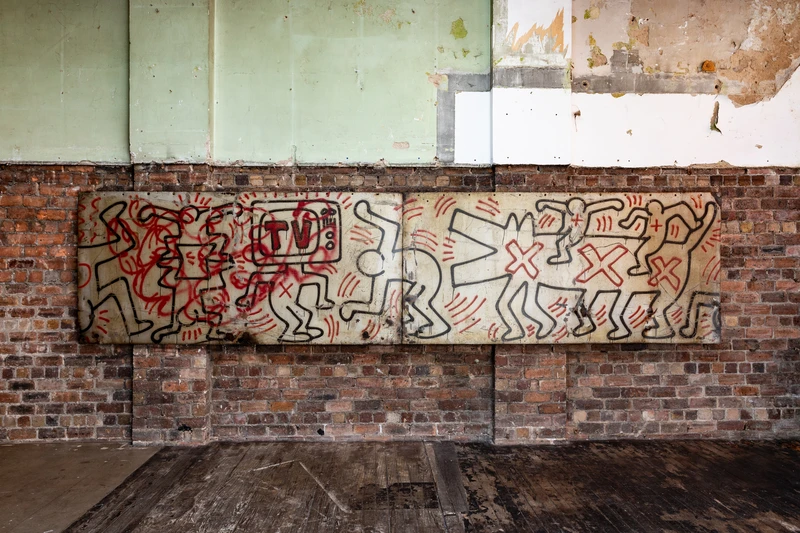Keith Haring: Subway Drawings
7 Jun-5 Sep 2024


I remember noticing a panel in the Times Square station and immediately going aboveground and buying chalk. After the first drawing things just fell into place. I began drawing on the subways as a hobby on my way to work. I had to ride the subways often and would do a drawing while waiting for a train.
— Keith Haring, ‘The Subway is Still My Favorite Place to Draw’ in Art in Transit: Subway Drawings (New York City: Harmony Books, 1984)
Keith Haring left for New York in 1978 to study at the School of Visual Art (SVA), the calligraphic line of Pierre Alechinsky still fresh in his mind from an exhibition he had seen at the Carnegie Institute Museum of Art, Pittsburgh, the year before. During his short period of study at SVA – he left in 1980 – Haring became interested in Umberto Eco and the study of semiotics, in particular ‘the way symbols are given meaning by language’. And amongst other artists of the counterculture, his new life in New York introduced him to Brion Gysin and William S. Burroughs – their concept of the cut-up as outlined in their influential book The Third Mind, 1978. In 1980, Haring found the perfect stage for this diverse set of influences to play themselves out – the New York City Subway.
Dynamic forms of graffiti dominated the tunnels and carriages of the subway in the 1980s even as a more affluent, mostly white, white-collar population (or ‘yuppies’) began to return to Manhattan following the election of Ronald Reagan and the city’s gradual recovery from a destructive fiscal crisis which emerged in the mid-1970s. The appearance of graffiti or ‘writing’ at this time and the semiotic intensity of the subway proved influential for Haring, and others of his generation, from Jean-Michel Basquiat to Jenny Holzer and David Wojnarowicz. The material transience or vulnerability of Haring’s drawings defined them against these more permanent writings and artworks.
Haring made hundreds, if not thousands, of subway drawings between 1980 and 1985. They were executed illegally with white chalk on the black paper panels that the Metropolitan Transit Authority used to cover advertisements between rentals. Haring was arrested many times while engaging in this activity though he reported that many cops were also fans. Constantly changing networks of commercial space resulted in the continual erasure of his work as new advertisements were posted. While this forced Haring to develop new ideas and imagery it also means that very few of these subterranean chalk frescoes now survive.
Haring’s highly legible visual language developed through his pressured and recurrent performance of drawing in the depths of the city. He reacted to the flux of urban life, his immediate surroundings but more generally to the concerns of the day – forms of sexuality regarded as taboo, commercial television, fraught politics, and atomic fear. Haring explored the city’s subconscious, its various repressions and fantasies, and outlined them in his underground work. The exhibition also comprises a section of Haring’s Untitled (FDR NY) mural from 1984. Untitled (FDR NY) was a 100-metre-long panel work which sat parallel to a section of New York City’s Franklin D. Roosevelt East River Drive, on Manhattan’s East Side. Like the subway drawings, this piece depicts images that existed outside of the space of mass culture and the crush of the commercial which defined the advertisements for magazines, films and other products that surrounded them. As they did when first produced, these works continue to provide room to breathe, a space for the imagination.
Keith Haring was born on May 4, 1958 in Reading, Pennsylvania and died at the age of thirty-one of AIDS related illness in New York City in 1990. Since his death, his work has been the subject of major solo exhibitions around the world, most recently at the Albertina Museum, Vienna. From 2013 through 2015, Haring was the subject of an international touring exhibition, Keith Haring: The Political Line, which travelled to the Musée d’Art Moderne de la Ville de Paris; the de Young Museum, San Francisco; and the Kunsthalle der Hypo-Kulturstiftung, Munich. In 1994, the Castello di Rivoli hosted a major solo exhibition of Haring’s work, and in 1997, the Whitney Museum of American Art staged a retrospective of Haring’s work that travelled internationally. In 2012, Keith Haring: 1978-1982, co-organised in 2010 by the Contemporary Arts Center, Cincinnati and the Kunsthalle Wien, Vienna, travelled to the Brooklyn Museum of Art. Haring’s work is in major private and public collections, including The Museum of Modern Art, New York; The Whitney Museum of American Art, New York; Los Angeles County Museum of Art, Los Angeles; The Art Institute of Chicago, Chicago; The Bass Museum, Miami; Centre Georges Pompidou, Paris; Ludwig Museum, Cologne; and Stedelijk Museum, Amsterdam. From June to November of 2019, the Tate Liverpool opened the artist’s first major solo exhibition in the United Kingdom that travelled to BOZAR Brussels in 2020.